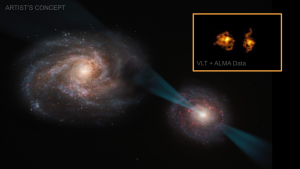
Researchers are learning that the jets associated with black holes can do more than we ever expected to destroy their surroundings. New data from the Atacama Large Millimeter Array and the Very Large Telescope have captured two galaxies in the process of colliding and merging into one system. Like two balls flying past one another on a bowl made of gravity, these two systems will pass back and forth multiple times before they settle into being one elliptical cloud of stars. During these crossings, the galaxies can pass each other at rates as high as 500 km/s, with shock waves and other effects driving dust, gas, and other material into the galaxies’ cores. As so often happens, one of these black holes has woken up and is actively feeding on the infalling material and is messily shooting out jets. What makes this system notable is where one of those jets is pointing.
Through random chance, these galaxies are aligned such that one of those jets is striking the heart of the other galaxy. As co-lead Sergei Balashev explains, “Here we see for the first time the effect of a quasar’s radiation directly on the internal structure of the gas in an otherwise regular galaxy.” With the combined, high-resolution efforts of two of the most powerful telescopes on Earth, the researchers have caught evidence of the quasar disrupting all but the densest clouds of gas and dust in the punctured galaxy. Where we would expect to see merging galaxies undergo runaway star formation, this system will go dark – there simply isn’t enough material left to form new stars like we’d expect.
So yeah… this black hole isn’t just killing a couple solar systems – it’s killing off a galaxy’s worth of solar systems.
